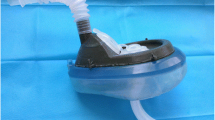Abstract
The patency of the airway via each orifice was examined during general anesthesia in 112 patients by occluding other orifices in order to develop a method in which fiberoptic endotracheal intubation (FEI) and ventilation could be performed via different orifices. Ventilation was well maintained via the mouth in 61 (54.5%), via bilateral nostrils in 87 (77.7%), and via the unilateral right and left nostril in 67 (59.8%) and 73 (65.2%) patients, respectively. With the aid of an artificial airway, ventilation was well maintained via the mouth in 112 (100.0%), via bilateral nostrils in 111 (99.1%), and via the unilateral right and left nostril in 106 (94.6%) and 105 (93.8%) patients, respectively. Based on these findings, we developed a method in which FEI is performed via the nostril, while ventilation is performed with a mask applied over only the mouth.
Similar content being viewed by others
References
Taylor PA, Toway RM (1972) The broncho-fiberscope as an aid to endotracheal intubation. Br J Anesth 44:611–612
Messeter KH, Pettersson KI (1980) Endotracheal intubation with the fibre-optic bronchoscope. Anesthesia 35:294–298
Edens ET, Sia RL (1981) Flexible fiberoptic endoscopy in difficult intubations. Ann Otol 90:307–309
Sia RL, Edens ET (1981) How to avoid problems when using the fibre-optic bronchoscope for difficult intubations. Anesthesia 36:74–75
Dellinger RP (1990) Fiberoptic bronchoscopy in adult airway management. Crit Care Med 18:882–887
Benumof JL (1991) Management of the difficult adult airway. With special emphasis on awake tracheal intubation. Anesthesiology 75:1087–1110
Patil V, Stehling LC, Zauder HL, Koch JP (1982) Mechanical aids for fiberoptic endoscopy. Anesthesiology 57:69–70
Rogers SN, Benumof JL (1983) New and easy techniques for fiberoptic endoscopy-aided tracheal intubation. Anesthesiology 59:569–572
Imai M, Kemmotsu O (1989) A new adapter for fiberoptic endotracheal intubation for anesthetized patients. Anesthesiology 70:374–375
Mcalpine G, Williams RT (1987) Fiberoptic assisted tracheal intubation under general anesthesia with IPPV. Anesthesiology 66:853
Nandi PR, Charlesworth CH, Taylor SJ, Nunn JF, Dore CJ (1991) Effect of general anaesthesia on the pharynx. Br J Anaesth 66:157–162
Morikawa S, Safar P, DeCarlo J (1961) Influence of the head-jaw position upon airway patency. Anesthesiology 22:265–270
Boidin MP (1985) Airway patency in the unconscious patient. Br J Anaesth 57:306–310
Nagaro T, Hamami G, Takasaki Y, Arai T (1993) Ventilation via a mouth mask facilitates fiberoptic nasal tracheal intubation in anesthetized patients. Anesthesiology 78:603–604
Author information
Authors and Affiliations
About this article
Cite this article
Nagaro, T., Hamami, G., Takasaki, Y. et al. The patency of the airway via each upper airway orifice during general anesthesia. J Anesth 9, 15–16 (1995). https://doi.org/10.1007/BF02482028
Received:
Accepted:
Issue Date:
DOI: https://doi.org/10.1007/BF02482028




